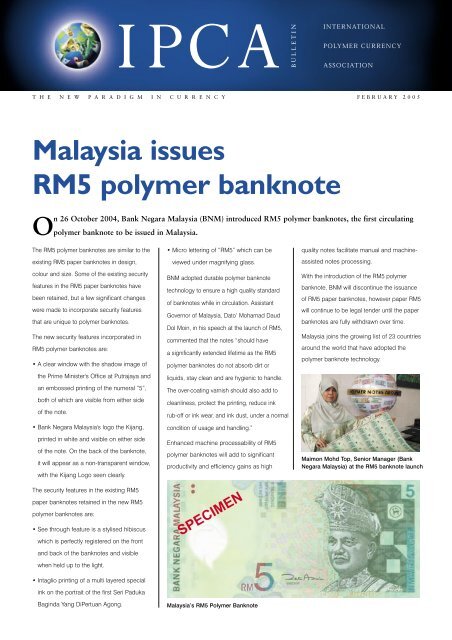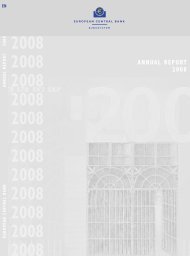SEC 028 IPCA English 0105 - Polymer Bank Notes of the World
SEC 028 IPCA English 0105 - Polymer Bank Notes of the World
SEC 028 IPCA English 0105 - Polymer Bank Notes of the World
You also want an ePaper? Increase the reach of your titles
YUMPU automatically turns print PDFs into web optimized ePapers that Google loves.
T H E N E W P A R A D I G M I N C U R R E N C YFEBRUARY 2005Malaysia issuesRM5 polymer banknoteOn 26 October 2004, <strong>Bank</strong> Negara Malaysia (BNM) introduced RM5 polymer banknotes, <strong>the</strong> first circulatingpolymer banknote to be issued in Malaysia.The RM5 polymer banknotes are similar to <strong>the</strong>existing RM5 paper banknotes in design,colour and size. Some <strong>of</strong> <strong>the</strong> existing securityfeatures in <strong>the</strong> RM5 paper banknotes havebeen retained, but a few significant changeswere made to incorporate security featuresthat are unique to polymer banknotes.The new security features incorporated inRM5 polymer banknotes are:• A clear window with <strong>the</strong> shadow image <strong>of</strong><strong>the</strong> Prime Minister's Office at Putrajaya andan embossed printing <strong>of</strong> <strong>the</strong> numeral “5”,both <strong>of</strong> which are visible from ei<strong>the</strong>r side<strong>of</strong> <strong>the</strong> note.• <strong>Bank</strong> Negara Malaysia's logo <strong>the</strong> Kijang,printed in white and visible on ei<strong>the</strong>r side<strong>of</strong> <strong>the</strong> note. On <strong>the</strong> back <strong>of</strong> <strong>the</strong> banknote,it will appear as a non-transparent window,with <strong>the</strong> Kijang Logo seen clearly.The security features in <strong>the</strong> existing RM5paper banknotes retained in <strong>the</strong> new RM5polymer banknotes are:• See through feature is a stylised hibiscuswhich is perfectly registered on <strong>the</strong> frontand back <strong>of</strong> <strong>the</strong> banknotes and visiblewhen held up to <strong>the</strong> light.• Intaglio printing <strong>of</strong> a multi layered specialink on <strong>the</strong> portrait <strong>of</strong> <strong>the</strong> first Seri PadukaBaginda Yang DiPertuan Agong.• Micro lettering <strong>of</strong> “RM5” which can beviewed under magnifying glass.BNM adopted durable polymer banknotetechnology to ensure a high quality standard<strong>of</strong> banknotes while in circulation. AssistantGovernor <strong>of</strong> Malaysia, Dato’ Mohamad DaudDol Moin, in his speech at <strong>the</strong> launch <strong>of</strong> RM5,commented that <strong>the</strong> notes “should havea significantly extended lifetime as <strong>the</strong> RM5polymer banknotes do not absorb dirt orliquids, stay clean and are hygienic to handle.The over-coating varnish should also add tocleanliness, protect <strong>the</strong> printing, reduce inkrub-<strong>of</strong>f or ink wear, and ink dust, under a normalcondition <strong>of</strong> usage and handling.”Enhanced machine processability <strong>of</strong> RM5polymer banknotes will add to significantproductivity and efficiency gains as highMalaysia’s RM5 <strong>Polymer</strong> <strong>Bank</strong>notequality notes facilitate manual and machineassistednotes processing.With <strong>the</strong> introduction <strong>of</strong> <strong>the</strong> RM5 polymerbanknote, BNM will discontinue <strong>the</strong> issuance<strong>of</strong> RM5 paper banknotes, however paper RM5will continue to be legal tender until <strong>the</strong> paperbanknotes are fully withdrawn over time.Malaysia joins <strong>the</strong> growing list <strong>of</strong> 23 countriesaround <strong>the</strong> world that have adopted <strong>the</strong>polymer banknote technology.Maimon Mohd Top, Senior Manager (<strong>Bank</strong>Negara Malaysia) at <strong>the</strong> RM5 banknote launch
<strong>Polymer</strong> banknotes in New ZeaIt is now five years since <strong>the</strong> first polymer notes were introduced intocirculation in New Zealand in May 1999 with all denominationsconverted to polymer by March 2000.Brian Lang, Head <strong>of</strong> Currency at <strong>the</strong> Reserve<strong>Bank</strong> <strong>of</strong> New Zealand, has recently completed<strong>the</strong> “Five Year Report” for polymer notes inNew Zealand and <strong>IPCA</strong> spoke to him about<strong>the</strong> New Zealand experience.What were <strong>the</strong> key driversfor <strong>the</strong> decision to adopt <strong>the</strong>polymer note technology?In 1996/97 we had a significant increase ingood quality paper counterfeits. Our concernwas that <strong>the</strong> key public security features forpaper notes at that time required <strong>the</strong> notes%9080706050403020100to be held up to <strong>the</strong> light for verification(watermark and thread) and this is anuncommon practice in New Zealand.The window area in a polymer note enableseasier verification.We also had continual public concern beingexpressed with <strong>the</strong> quality <strong>of</strong> our paper $5 and$10 notes with soiling and limpness affecting<strong>the</strong>se denominations quite badly. The publicsees <strong>the</strong> cleanliness <strong>of</strong> <strong>the</strong> notes as <strong>the</strong> keybenefit <strong>of</strong> polymer. Lower cost <strong>of</strong> issue is anindirect benefit that helps justify <strong>the</strong> conversionbut is not <strong>of</strong> particular relevance to <strong>the</strong> public.<strong>Notes</strong> destroyed as a percentage <strong>of</strong> notes in circulation1001997/98 Paper2003/04 <strong>Polymer</strong>$5 $10 $20 $50 $100 TOTALDenominationBrian Lang (Currency Manager,Reserve <strong>Bank</strong> <strong>of</strong> New Zealand, 2004)What are <strong>the</strong> key benefits <strong>of</strong><strong>the</strong> polymer notes for <strong>the</strong>community?The key benefit <strong>of</strong> polymer notes to <strong>the</strong>community in New Zealand is <strong>the</strong> ability <strong>of</strong><strong>the</strong> notes to retain <strong>the</strong>ir structure and remainrelatively clean. People see this as THEmajor benefit <strong>of</strong> polymer. There has alsobeen a very significant drop in <strong>the</strong> number <strong>of</strong>counterfeits to <strong>the</strong> extent that very few aredetected at <strong>the</strong> Central <strong>Bank</strong> (0.27counterfeits per million notes in circulation in2003/04).What have been <strong>the</strong> o<strong>the</strong>rbenefits <strong>of</strong> <strong>the</strong> polymer notesin New Zealand?The key focus is to provide currency to <strong>the</strong>public as efficiently and effectively as possible.From a cost/benefit point <strong>of</strong> view we have18Counterfeitsseen significant savings in <strong>the</strong> provision <strong>of</strong>banknotes and currency operations.Per millionnotes incirculation16141210864201997 1998 1999 2000 2001 2002 2003 2004YearNote issue costs have been reduced by 54%in <strong>the</strong> past four years, saving NZ$7.7 million.We believe that we have now <strong>of</strong>fset all ourconversion costs and will have ongoingsavings for <strong>the</strong> foreseeable future.The polymer notes are maintaining a highlevel <strong>of</strong> quality and durability in circulationwith average unfit note rates <strong>of</strong> 14% in2003/04 compared with 63% for paper notesin 1997/98.The counterfeits detected in 2000 and 2001 were all paper notes (mainly $10 and $50 noteswhich were <strong>the</strong> last denominations to be converted to polymer). To date we have detected nocounterfeits reproduced on polymer; all have been produced on paper. In <strong>the</strong> year ending 30June 2004 we machine processed 66 million notes and detected just 28 counterfeits.We have been able to considerablydownsize Central <strong>Bank</strong> cash operations inNew Zealand and I believe that <strong>the</strong> success
land “The Five Year Report”and speed with which this was achievedin 2000/01 was directly attributable to <strong>the</strong>polymer conversion. This was partly dueto <strong>the</strong> fact that we had a complete “refresh”<strong>of</strong> notes in circulation, but <strong>the</strong> ongoing ability<strong>of</strong> polymer notes to retain <strong>the</strong>ir structure,significantly reduces <strong>the</strong> need for <strong>the</strong> Central<strong>Bank</strong> to continually machine process tomaintain quality.The very low counterfeit rate <strong>of</strong> polymernotes has also reduced our need to monitorrigorously for validity. We have reducedannual cash operation costs by 55%between 1997/98 and 2003/04.In view <strong>of</strong> your experience,what would be yourrecommendation to o<strong>the</strong>rCentral <strong>Bank</strong>s considering <strong>the</strong>polymer note technology?In my view <strong>the</strong> key benefits <strong>of</strong> <strong>the</strong> polymernotes for <strong>the</strong> public (cleanliness, structure,more effective security features) are readilytransferable to o<strong>the</strong>r countries even though<strong>the</strong> cost <strong>of</strong> issue results may differ. Havingexperience issuing both paper and polymernotes, it is now more important than ever forissuers to properly assess <strong>the</strong>se verysignificant benefits <strong>of</strong> polymer notes.Cost per notein circulation(NZ cents)Issue Cost per <strong>Bank</strong>note in Circulation10864201997 1998 1999 2000 2001 2002 2003 2004YearFor <strong>the</strong> years ending 30 June 1997 and 1998 only paper notes were issued. In 1999 and 2000 all papernotes were withdrawn and replaced with polymer. In 2001 to 2004 only polymer notes were issued.Cents pernote inCirculation(NZ cents)Functional Cost per <strong>Bank</strong>note in Circulation3025201510501997 1998 1999 2000 2001 2002 2003 2004YearThe above graph illustrates <strong>the</strong> very significant reduction in total operating expenses, includingnote issue, since 2001 after <strong>the</strong> <strong>Bank</strong> introduced polymer banknotes, closed its branches andscaled down its note processing role. The higher cost in 1999 was attributable to <strong>the</strong> completeconversion <strong>of</strong> paper banknotes to polymer and Y2K contingencies.Romania announces <strong>Polymer</strong> RedenominationThe National <strong>Bank</strong> <strong>of</strong> Romania(NBR) has announced that as<strong>of</strong> 1 July 2005, Romania's currencywill be subject to a redenomination.From that dateRomania’scurrency (leu)will be dropping4 zeroes.The reason for <strong>the</strong> redenomination is tosignify <strong>the</strong> end <strong>of</strong> a long period post 1989typified by relatively high inflation, to pricestability. The big advantage for <strong>the</strong> publicwill be <strong>the</strong> simplification in handling andcalculating monetary amounts. Double pricing<strong>of</strong> goods will start from 1 March, enabling<strong>the</strong> public to become familiar prior to <strong>the</strong><strong>of</strong>ficial introduction.Romania started issuing Guardian ® polymerbanknotes in 1999 and has since replaced allits circulating banknotes with polymer.Currently 5 denominations are in circulation.Guardian ® has again been chosen for <strong>the</strong> newbanknote series, confirming <strong>the</strong> excellentexperience <strong>of</strong> NBR with polymer, and <strong>the</strong>ircommitment to its continuing future benefits.The <strong>Bank</strong> states on its website <strong>the</strong>advantages <strong>of</strong> polymer as “improved security,increased resistance in circulation, betterprocessing in all types <strong>of</strong> equipment,cleanliness (fewer bacteria) and recyclability”.Fur<strong>the</strong>r details on <strong>the</strong> new banknotes will bemade public in <strong>the</strong> next months.
<strong>Polymer</strong>.Your questions answeredQ.What is <strong>the</strong> difference betweenintaglio plate making for paperbanknotes and intaglio plate makingfor polymer banknotes?A. The actual intaglio plate making process forpolymer banknotes can be identical to thatused for paper notes. For example handengraving or photopolymer originationmethods work just as well for bothsubstrates. Hence a security print works canmaintain <strong>the</strong>ir existing plate makingprocesses and equipment when <strong>the</strong>y moveto polymer. The critical difference whenmaking intaglio plates for printing onpolymer is at <strong>the</strong> design stage and in <strong>the</strong>geometry <strong>of</strong> engraving.To reduce <strong>the</strong> possibility <strong>of</strong> splurging,certain line shapes should be avoided, forexample “V” shaped or arrow shapedfeatures in <strong>the</strong> wiping direction should notbe used.Because polymer substrate has a highercompressive and tensile strength than paper,it requires more pressure in <strong>the</strong> intaglio nip todeform and make contact with <strong>the</strong> ink in <strong>the</strong>engraving. Therefore we recommend reducing<strong>the</strong> depth <strong>of</strong> wide lines slightly.Q.When polymer notes reach <strong>the</strong>end <strong>of</strong> <strong>the</strong>ir circulating life, how are<strong>the</strong>y destroyed and disposed <strong>of</strong>?A. <strong>Polymer</strong> notes are deemed to be unfit due to:• Mechanical wear and tears (includingsticky tape), holes, both physical holesthrough <strong>the</strong> entire note and removal <strong>of</strong><strong>the</strong> coatings on both sides <strong>of</strong> <strong>the</strong> noteand heat damage where <strong>the</strong> note hasbecome deformed or is partly destroyeddue to excessive heat.• Ink wear where <strong>the</strong> abrasion <strong>of</strong> <strong>the</strong>note has rendered <strong>the</strong> note’s printed indiciadifferent to <strong>the</strong> mint quality note.These notes are ei<strong>the</strong>r outsortedmanually by cash handlers such as banktellers or cash transport companyemployees, or by detectors throughmechanical note processing. Theoutsorted unfit notes are <strong>the</strong>n granulatedinto small pieces. These are taken byrecyclers who feed <strong>the</strong>m into extruderswhich produce pellets. The pellets can<strong>the</strong>n be used in any polypropyleneextruder to create a range <strong>of</strong> usefulproducts such as garden equipment ando<strong>the</strong>r durable products.<strong>Polymer</strong> notes can be recycled into a range <strong>of</strong>products including compost bins, wheelbarrows,and a range <strong>of</strong> o<strong>the</strong>r useful productsInternational eventsConference Location Date Website20055th Security Printing & Alternative Solutions Moscow, Russia January 26-27 www.security-printing.comin Central/Eastern Europe & Russia/CIS 2005<strong>Bank</strong>note 2005 Washington DC, USA February 20-23 www.banknote2005.comAsian <strong>Bank</strong>er Summit 2005 Singapore March 15-17 www.<strong>the</strong>asianbanker.com2nd Pan-European High Security Kiev, Ukraine April 20-21 www.cross-conferences.comPrinting Conference2005 Annual Meeting <strong>of</strong> <strong>the</strong> <strong>World</strong> <strong>Bank</strong> Group Washington DC, USA September 26-27 www.imf.org& International Monetary FundCurrency Conference Montréal Québec, Canada October 2-5 www.currencyconference.comFor more industry news, polymer facts and currencyhot topics, look out for <strong>the</strong> next issue <strong>of</strong> <strong>IPCA</strong> Bulletin.Enquiries www.ipca.au.comBack issues <strong>of</strong> <strong>IPCA</strong> Bulletin can be foundon <strong>the</strong> <strong>IPCA</strong> website: www.ipca.au.com© Copyright 2005 International <strong>Polymer</strong> Currency Association. No part<strong>of</strong> this bulletin may be reproduced without prior consent from <strong>IPCA</strong>.ORIGINATION CRM <strong>SEC</strong> <strong>028</strong> <strong>0105</strong>





![KNOW YOUR NEW GIBRALTAR BANKNOTES - [Home] bThe/b](https://img.yumpu.com/50890985/1/184x260/know-your-new-gibraltar-banknotes-home-bthe-b.jpg?quality=85)
![PAPUA NEW GUINEA - [Home] - Polymer Bank Notes of the World](https://img.yumpu.com/49758743/1/190x143/papua-new-guinea-home-polymer-bank-notes-of-the-world.jpg?quality=85)









